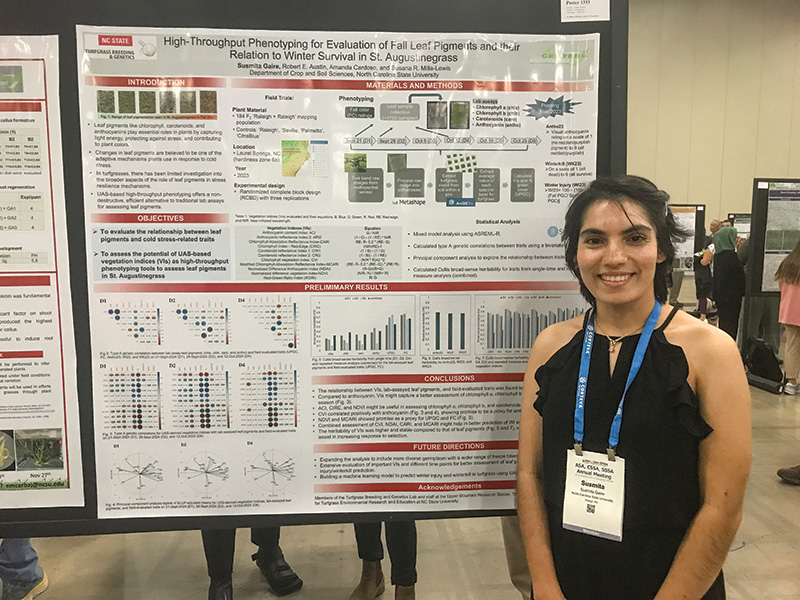
High-throughput phenotyping for evaluation of fall leaf pigments and their relation to winter survival in St. Augustinegrass
Leaf pigments, such as chlorophyll, carotenoids and anthocyanins, are crucial for plants’ responses to cold stress and acclimation. During cold acclimation, chlorophyll often decreases to minimize photodamage, while carotenoid and anthocyanin levels increase, providing photoprotection and antioxidant defense. Limited research has focused on phenotyping leaf pigments in turfgrasses and evaluating their role in cold tolerance. Traditional lab assays for estimating leaf pigments are time-consuming, tedious and impractical for large breeding populations. High-throughput phenotyping (HTP) using unoccupied aerial systems (UAS) with multispectral and red-green-blue (RGB) sensors offers a resource-efficient alternative to assess these pigments through vegetative indices (VIs). However, these traits need validation against ground-truth measurements.
This study aims to evaluate, 1) the relationship between leaf pigments and winter survival in St. Augustinegrass and, 2) the potential use of UAS-based VIs to assess leaf pigments under cold-stress conditions. One hundred eighty-four genotypes and checks of Raleigh, Seville, Palmetto and Citrablue were planted at the Upper Mountain Research Station (Laurel Springs, N.C.) in May 2023 in an RCBD with three replications. Field plots were evaluated for fall color (FC), winter injury (WI) and winterkill (WK). Percent green cover and VIs were collected using UAS. Additionally, chlorophyll, carotenoid and anthocyanin content were measured from leaf samples collected from the field in the fall. While ACI, CIRE and NDVI were significantly correlated with chlorophyll a, b and carotenoids, CVI correlated positively with anthocyanin. Furthermore, NDVI and MCARI showed promise as proxies for PGC and FC, and combined assessment of CVI, NDAI, CARI and MCARI might enhance WI and WK prediction. Furthermore, heritability for VIs was higher and more stable than leaf pigments, suggesting they might assist in increasing response to selection. Overall, our results indicate that evaluating leaf pigments via UAS-derived VIs offers promise in evaluating cold tolerance traits in St. Augustinegrass.
— Susmita Gaire (sgaire@ncsu.edu); Robert Austin; Amanda Cardoso, Ph.D.; and Susana R. Milla-Lewis, Ph.D.; North Carolina State University, Raleigh

Modeling large patch epidemics in zoysiagrass using remote sensing and environmental factors
Large patch (Rhizoctonia solani AG 2-2 LP) is the most destructive disease on zoysiagrass (Zoysia spp.). Literature surrounding the spatial and temporal dynamics of large patch epidemics is scarce, so one objective of this study is to characterize large patch epidemics over multiple seasons and years. Utilizing drone technology and GIS software will aid in the analysis of disease spread. Additionally, the environmental factors that influence large patch epidemics are not well understood. Previous research suggests higher soil moisture and higher organic matter lead to a higher probability of certain turfgrass diseases, but no comprehensive epidemiological study has been conducted on large patch of zoysiagrass. Therefore, a study was conducted to determine the spatial and temporal dynamics of large patch epidemics as well as the environmental factors that drive large patch epidemics.
In this study, 100 quadrants were established across four trial sites. Three sites were established on golf course fairways at Eagle Crest Golf Course in Alma, Ark., while the other was at the University of Arkansas Experiment Station in Fayetteville. Volumetric water content, thatch depth, soil salinity, soil organic matter, soil pH and soil nutrient data were all measured to develop a model for predicting turfgrass areas that have high risk of large patch. The spatial distribution of the disease was determined by calculating index of dispersion values of the percent large patch in each plot. Early findings suggest a moderate, negative correlation (r = -0.385) between soil pH and the percentage of large patch present. Finally, we found that the index of dispersion values show large patch is an aggregated disease. We anticipate constructing a prediction model from the results that can categorize disease severity for precision applications.
— Samuel Thomas Kreinberg (stkreinb@uark.edu); Jason Davis, Ph.D.; Michael D. Richardson, Ph.D.; Hannah Smith, Ph.D.; and Wendell J. Hutchens, Ph.D.; University of Arkansas, Fayetteville
Darrell J. Pehr (dpehr@gcsaa.org) is GCM’s science editor.